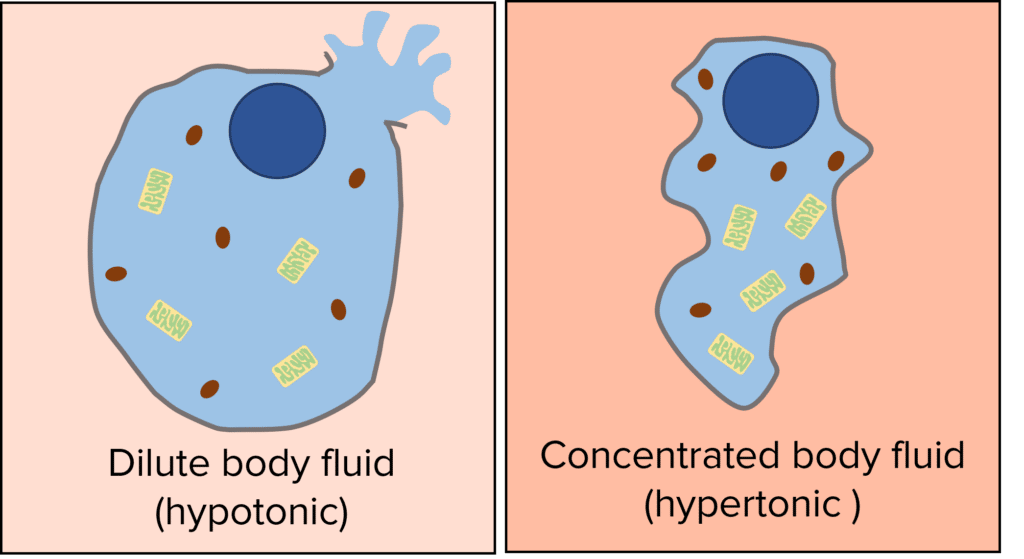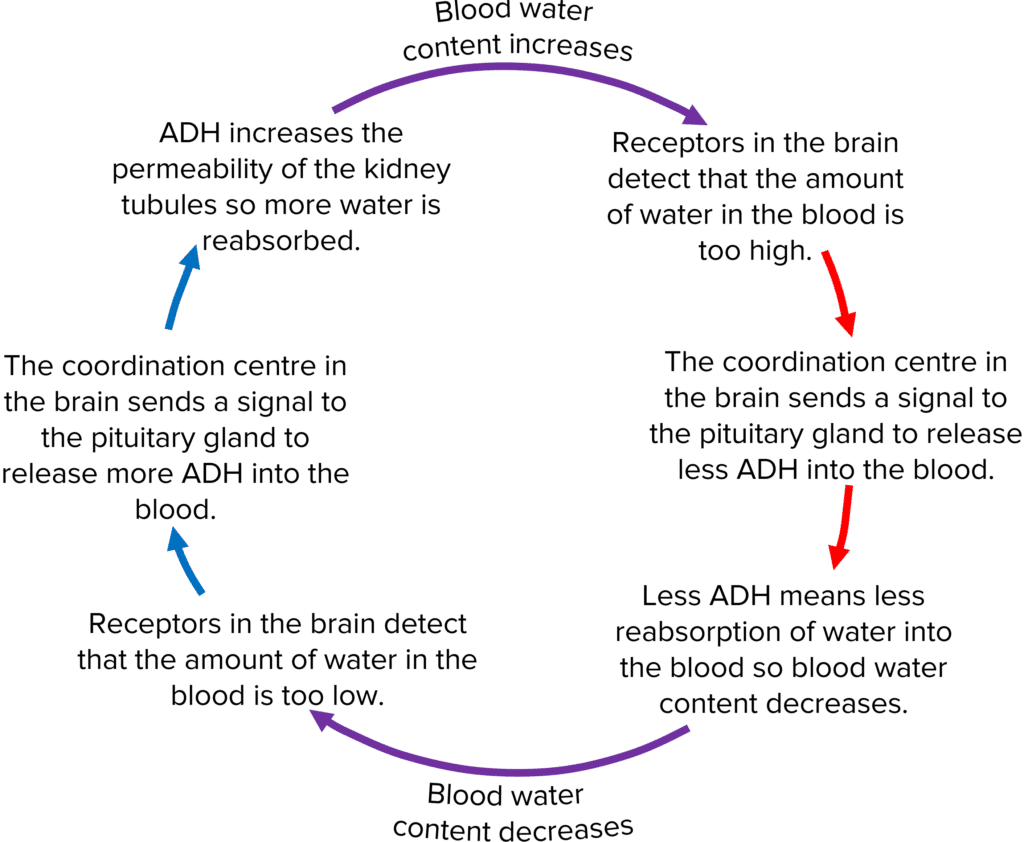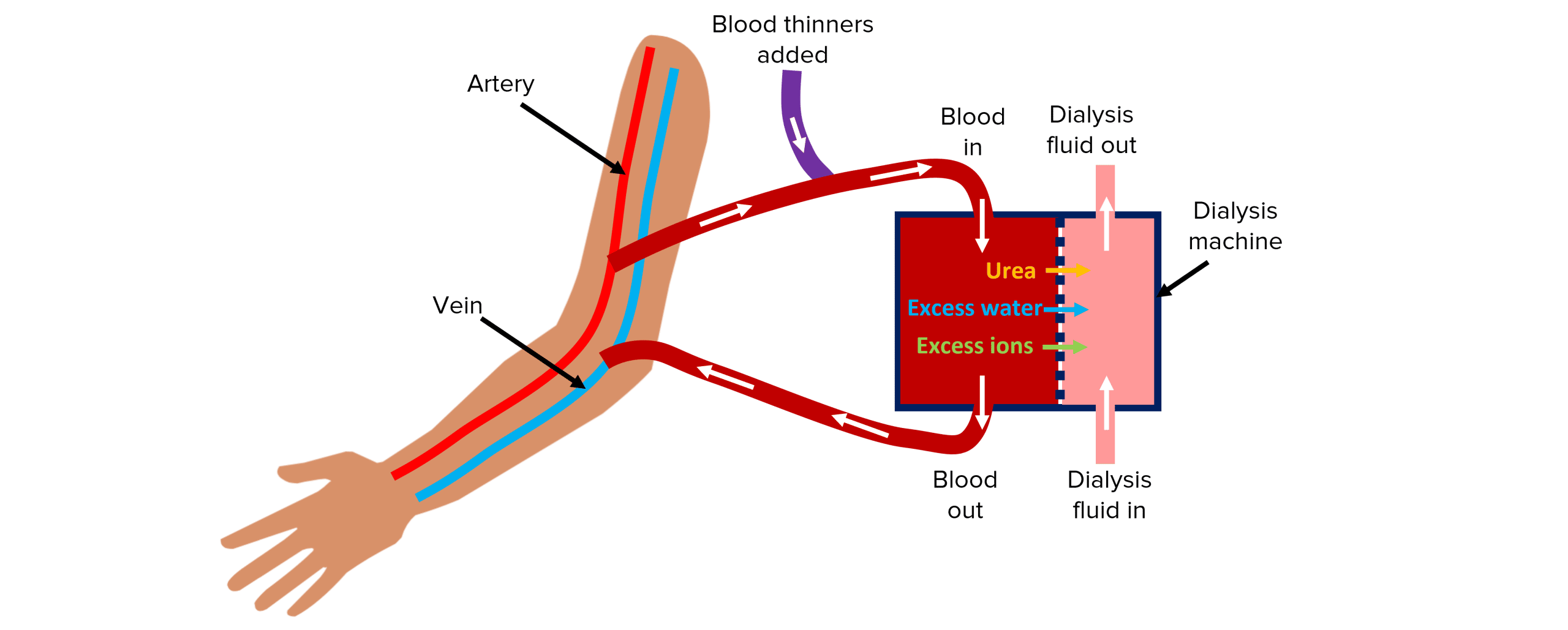Maintaining Water and Nitrogen Balance
Maintaining Water and Nitrogen Balance Revision
Maintaining Water and Nitrogen Balance
For body cells to work efficiently, they require the right amounts of water and nitrogen. The kidneys control how much water and nitrogen is lost from the body via the urine. The hormone ADH is responsible for controlling the amount of water that is expelled from the body as part of a negative feedback cycle. Kidney failure can be fatal but can be treated using dialysis or kidney transplants.
Maintaining Water Levels

All cells contain water, but if they have too much or too little, they will not be able to function efficiently.
If body fluids surrounding the cells are more dilute (hypotonic) than inside the cell, water will move into the cells via osmosis. This can cause cells to burst. If body fluids surrounding the cells are more concentrated (hypertonic) than inside the cell, water will move out the cells via osmosis. This can cause cells to shrivel.
Controlling the balance between water loss and gain in the body is therefore an essential bodily process. Humans ingest water through food and drink and also produce it as a by-product of respiration. Water is lost from the body uncontrollably in your breath when you exhale and also in sweat (along with some ions and urea).
The kidneys tightly control water loss via the urine to ensure the body contains the optimum amount of water for cells to function.
Maintaining Nitrogen Levels
Humans ingest proteins in food that get digested into amino acids and absorbed into the blood. As amino acids and proteins cannot be stored in the body, any excess amino acids must be excreted. The body must first convert them into urea, which is a two step process:
- The amino acids are deaminated in the liver to form ammonia. This means the nitrogen–containing part (amino part) of the molecule is removed from the rest of the molecule.
- Ammonia is toxic so the body immediately converts it into urea which can be excreted safely via the kidneys.
Kidney Function
The kidneys are responsible for removing waste products and excess molecules from the blood. This forms urine which is then stored in the bladder and released from the body through the urethra.
The kidneys begin by filtering the blood, removing urea (from broken down proteins), ions, glucose and excess water.
Then they undergo selective reabsorption which is where useful molecules like glucose, some ions and water diffuse back into the blood. This ensures that the body keeps the right amount of water and other molecules that is needs to function.
Anti-Diuretic Hormone (ADH)
ADH is a hormone that increases the permeability of the walls of the kidney tubules to water. This means more water is reabsorbed into the blood and the water content of the blood increases.
The amount of water in the blood is controlled by changing the amount of ADH that gets released, in a negative feedback cycle:

- Receptors in the brain detect that the blood water concentration is too high or low and send signals to the coordination centre in the brain.
- The coordination centre sends signals to the pituitary gland to release more ADH if blood water content is too low or less ADH if blood water content is too high.
- Increasing the amount in ADH will increase reabsorption of water into the blood and increase the concentration of water in the blood to a normal level. Decreasing the amount in ADH will decrease reabsorption of water into the blood and decrease the concentration of water in the blood to a normal level.
Kidney Failure
Kidneys can stop working due to damage or disease. This causes waste to build up in the body, the balance of water, glucose and ions to be disrupted and can even be fatal.
Luckily, the body can survive with only one functioning kidney and advancements in treatments have made the condition more manageable.
Dialysis is a common treatment for kidney failure.
The patient’s blood flows from an artery in the arm into a dialysis machine, where waste products get filtered out and the balance of ions and water is restored, before being returned to the body via a vein in the arm.
The patients blood is mixed with blood thinners to prevent clotting and aid the movement of the blood through the machine.
Inside the dialysis machine, there is a partially permeable membrane that separates the blood from dialysis fluid. The dialysis fluid has a similar concentration of glucose, water and ions to the blood and no urea.
As the dialysis fluid flows in the opposite direction to the blood, concentration gradients are created and substances are exchanged between the two fluids. Urea, excess ions and excess water is removed from the blood and glucose remains in the blood for use in the body.

Disadvantages:
- It is a very time-consuming and restrictive process; patients have to have dialysis many times a week and each session can take several hours.
- The equipment is very specialised and expensive.
- Diet must be tightly controlled between sessions.
- Will be effective for a limited time before a transplant is required.
Kidney transplants can cure kidney failure.
Healthy kidneys from donors are transplanted into patients whose kidneys do not function well.
Kidneys can be donated from the recently deceased or from living people with two kidneys who are willing to sacrifice one of theirs (this comes with some risks to the donor).
Transplanted kidneys are often rejected by the patients immune system but drugs can be given to prevent this.
Transplants are cheaper than dialysis in the long run and save patients a lot of time as they will no longer require dialysis.
Unfortunately, waiting lists for kidney transplants are very long and dialysis is often used to keep patients alive until one becomes available.
Maintaining Water and Nitrogen Balance Example Questions
Question 1: How are excess amino acids removed from the body?
[3 marks]
- Amino acids are deaminated in the liver to form ammonia.
- Ammonia is converted into urea.
- Urea is filtered out of the blood by the kidneys.
Question 2: Explain how the body detects and responds to low water content in the blood.
[4 marks]
- Low water content is detected by receptors in the brain.
- Pituitary gland releases more ADH into the blood.
- ADH increases the permeability of kidney tubules to water.
- More water is reabsorbed into the blood and water content increases.
Question 3: Evaluate the advantages and disadvantages of treating kidney failure with dialysis and kidney transplants.
[4 marks]
One from each
Advantage of dialysis:
- Readily available/ no waiting list
- No need for immune-suppressant drugs
Disadvantage of dialysis:
- Time-consuming
- Restrictive/ need to be near hospital
- Expensive equipment
- Controlled diet between sessions
- Only effective for a limited amount of time.
Advantage of kidney transplant:
- Patients can lead a normal life
- Cheaper overall
Disadvantage kidney transplant:
- Risk of rejection is high.
- Very long waiting list/reliant on donors
- Have to take immune-suppressant drugs to prevent rejection.
- Risks with operations (to patient and donor)
- Kidneys will only last approx. 8-9 years.

MME Premium Membership
£19.99
/monthLearn an entire GCSE course for maths, English and science on the most comprehensive online learning platform. With revision explainer videos & notes, practice questions, topic tests and full mock exams for each topic on every course, it’s easy to Learn and Revise with the MME Learning Portal.
Sign Up Now


